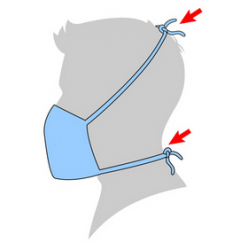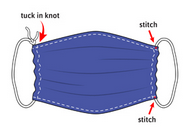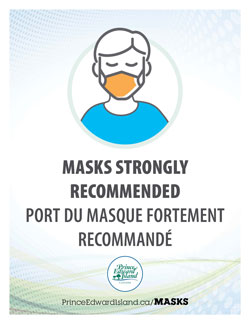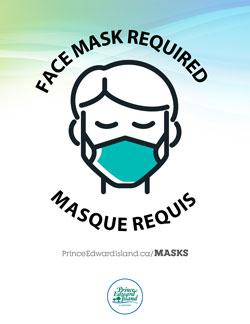Wearing Masks in the Community and Workplaces
Wearing a mask in the community is a measure to protect you and those around you, even if you don’t have symptoms.
People in Prince Edward Island are no longer required to wear masks in indoor public places, schools, or in workplaces where distancing cannot be maintained. It is important that anyone, who chooses to continue wearing a mask, be supported in their decision.
Masking in certain high-risk settings, including hospitals, long-term care, and community care homes may still be required by individual facilities. Individuals are asked to consult the policies for specific facilities for COVID-19 related protocols, such as masking.
General COVID-19 public health guidance for individuals, businesses and organizations where requirements are no longer in place can be found here.
Frequently Asked Questions
What type of mask to choose?
Different types of masks are available for public use. Non-medical masks, medical masks and respirators can all be used in the community. The effectiveness of non-medical masks depends on material, construction, fit and proper use. A mask is most effective when it is worn properly. Keep your nose and mouth covered while wearing a mask to prevent exposing yourself and others to potentially infectious respiratory particles.
Non-medical masks can be homemade or commercial. Non-medical face masks should:
- Be made of at least 2 layers of breathable tightly woven material fabric (such as cotton or linen) and; an effective middle filter layer. - such as non-woven polypropylene fabric*
- Include a filter in your non-medical mask by:
- Adding a filter fabric as a middle layer
- Inserting a disposable filter into a pocket on the inside of the mask
- Filters can be purchased or you can prepare your own using a piece of filter fabric
Fit is important for all mask types:
- Be large enough to completely and comfortably cover the nose, mouth and chin without gaping and not allow air to escape from the edges.
- Masks with a flexible nose piece may provide a better fit over the nose.
- Fit securely to the head with ties or ear loops, adjustable ear loops improve fit.
- Allow for easy breathing
- Be comfortable and not require frequent adjustment
- Be changed as soon as possible if damp or dirty
- Maintain its shape after washing and drying
In general, while non-medical masks can help prevent the spread of COVID-19, medical masks and respirators provide better protection. No matter which type of mask you choose, proper fit is a key factor in its effectiveness.
Ways to improve fit include:
- Adjusting ties or ear loops
- Adjusting the flexible nose piece
- Tying knots in the ear loops and tucking the sides of the masks so that it lies flat
- Using a mask fitter or brace
- A mask fitter or brace is a device made of flexible material worn over a mask to help provide a snug fit (may be made of plastic or silicone).
- Layering a well-fitting non-medical cloth mask over the top of disposable mask to improve the fit.
- Keeping facial hair and beards shaved short, if possible, so the mask can fit more closely to your face.
Proper use and care
To make mask use as effective as possible, it’s essential to make sure you’re using, storing and cleaning them properly.
A mask is most effective when it is worn properly. Keep your nose and mouth covered while wearing a mask to prevent exposing yourself and others to potentially infectious respiratory particles.
Wash your hand or use alcohol based hand sanitizer when you:
- Adjust your mask
- Put your mask on
- Take your mask off
It is important to keep your mask clean when not in use.
Do not hang the mask from your ears or place it under your chin.
Properly clean and disinfect any items that improve mask fit such as braces and mask fitters.
Discard disposable masks and filters properly in a garbage container or recycle if appropriate.
Non-medical masks
Change your mask as soon as possible if it gets dirty, damp or damaged. Place dirty reusable non-medical masks is a secure, waterproof bag or container until you can wash them in the laundry.
Medical masks and respirators
Medical masks and respirators are typically single use and disposable, but may be reused until visibly dirty, damp or damaged.
*Guidance from the Public Health Agency of Canada recommends 3-layer masks. At this time, Islanders should continue to use their 2-layer masks. As we replace our masks, we should purchase 3-layer masks that includes a middle filter layer.
Non-medical masks should not:
- Be placed on children under the age of 2 years

- Be placed on anyone unable to remove them without assistance or anyone who has trouble breathing
- Be made exclusively of materials that easily fall apart, such as tissues
- Have exhalation valves
- Be secured with tape or other inappropriate materials
- Be shared with others
- Be allowed to hang from your ears
- Be placed under your chin
- Impair vision or interfere with tasks
Can I wear a face shield, spit guard, or another mask alternative?
No. Alternatives—including face shields, spit guards, gaiters, scarves—are not as effective at preventing the transmission of viruses as non-medical masks. Face shields and spit guards do not effectively contain the spray of respiratory droplets. Neck gaiters and scarves aren't well secured to the head or ears, and are difficult to remove without contaminating yourself.
well secured to the head or ears, and are difficult to remove without contaminating yourself.
In some instances, face shields can be worn in addition to non-medical masks, as an added layer of protection. Service providers that require their client’s face to be uncovered (eg. facials, dental procedures) should consider eye protection, such as a face shield, in addition to a mask.
Should I wear a mask with an exhalation valve?
No. Do not use masks or respirators with exhalation valves. These masks do not protect others from COVID-19 or limit the spread of the virus. This is because they allow infectious respiratory droplets to spread outside the mask.
Face shields, spit guards, gaiters and scarves are not substitutes for non-medical masks.
How do I put on a mask?
- Ensure the face covering is clean and dry, and free of tears or holes.
- Whenever possible, wash your hands with warm water and soap for at least 20 seconds or use hand sanitizer with a 60-80% alcohol base.
- Ensure your hair is away from your face.
- Place the face covering over your nose and mouth and secure to your head or ears with its ties or elastics. Adjust, if needed, to ensure nose and mouth are fully covered. The mask should fit snugly to the cheeks and there should not be any gaps.
- Repeat step 2.
While wearing a mask, it is important to avoid touching your face. If you do touch your mask or face, you should immediately wash your hands with warm water and soap for at least 20 seconds. You can also use hand sanitizer with a 60-80% alcohol base.
Masks and face coverings are only effective if worn properly. Uncovering your nose or mouth while wearing one:
- Eliminates any protection it may offer
- Allows you to breathe in and exhale potentially infectious respiratory droplets
How do I remove a mask?
- Whenever possible, wash your hands with warm water and soap for at least 20 seconds. If not available, use hand sanitizer with a 60-80% alcohol base.
- Remove the face covering by un-tying it or removing the loops from your ears. Avoid touching the front of the mask when removing it. It can be placed in a plastic bag temporarily if possible (make sure you close or zip seal the bag while storing it).
- If you plan to reuse the mask, wash it before wearing it again. It can be washed with hot, soapy water, or it can be washed with your other laundry.
- After removing the face covering, repeat Step 1.
You should try to reduce the number of times you take your mask off and put it back on. If entering and exiting multiple indoor spaces where masks are required, consider leaving your mask on for the duration of your outing.
It is important to keep your mask clean when not in use, or when eating or drinking. Store it in a clean paper or cloth bag until you put it on again. Soiled masks should be placed in a secure, waterproof bag or container until they can be washed in the laundry.

